Hi Everybody!!
Did anybody guess the berries pictured above? How about the Muscadines? Give yourself *Gold Stars* if you guessed both! I drove out to a country road to photograph these fruits for you to see. The berries are from a Toothache Tree. The Muscadines are wild grapes growing on big vines. Both are in your photostudy tonight. Next, I drove to Cypress to a big Garden Shop and caught some "Hot Bloomers" in action! One of the most important things to know about planting flowers is: What zone You live in. Only buy flowers for your zone or you will be sorry with the results! Okay, I am off to make wild grape jelly. Get you some grapes and try it! Enjoy!
http://en.wikipedia.org/wiki/Zanthoxylum_clava-herculis
Zanthoxylum clava-herculis
From Wikipedia, the free encyclopedia
| Zanthoxylum clava-herculis | |
|---|---|
 | |
| Xanthophyllum clava-herculis (Hercules' Club) | |
| Scientific classification | |
| Kingdom: | Plantae |
| (unranked): | Angiosperms |
| (unranked): | Eudicots |
| (unranked): | Rosids |
| Order: | Sapindales |
| Family: | Rutaceae |
| Genus: | Zanthoxylum |
| Species: | Z. clava-herculis |
| Binomial name | |
| Zanthoxylum clava-herculis | |
Zanthoxylum clava-herculis, the Hercules' Club (or Hercules-club), pepperwood, or Southern prickly ash, is a spinytree or shrub native to the southeastern United States. It grows to 10–17 m tall and has distinctive spined thick, corky lumps 2–3 cm long on the bark. The leaves are glabrous and leathery,[1] pinnately compound, 20–30 cm long with 7-19 leaflets, each leaflet 4–5 cm long. The flowers are dioecious, in panicles up to 20 cm long, each flower small, 6–8 mm diameter, with 3-5 white petals. The fruit is a two-valved capsule 6 mm diameter with a rough surface, and containing several small black seeds. The tree has also been called Z. macrophyllum. The genus name is sometimes spelled Xanthoxylum.
Along with the related Zanthoxylum americanum, it is sometimes called "toothache tree"[2][3] or "tingle tongue" because of the numbness of the mouth, teeth, and tongue induced by chewing on its leaves or bark (thus relieving toothache). It was used for such medicinal purposes by both Native Americans and early settlers.[4]
The tree has a rounded crown and requires plentiful water and sunlight. Its leaves are browsed by deer and its fruit is eaten by birds. The fruit passes through birds, which helps the seeds to germinate.[4] The new trees tend to sprout below the favorite resting places of the birds, along fence rows and the edge of woods.[5] It is known to be host to a number of insect species, including the Giant Swallowtail(Papilio cresphontes) and the leaf beetle Derospidea brevicollis.
Chemistry[edit]
The benzophenanthridine alkaloid chelerythrine is the major active natural product found in Z. clava-herculis, exhibiting anti-bacterial activity against Staphylococcus aureus.[6]
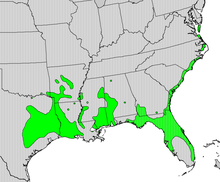
Excerpt from Google Blogger Merriweather's Foraging Texas. (Great site-I joined)
Visit link for complete article:
http://www.foragingtexas.com/2008/08/prickly-ashtoothache-tree.html
Merriwether's Guide to Edible Wild Plants of Texas and the Southwest
These trees produce a massive amount of bright red berries in the fall. In China the dried, roasted berries of similar species of Zanthoxylums are used as the main ingredient of Sichuan seasoning. Pick the ripe berries and let them dry until they split open revealing dark seeds. Remove the seeds and coarse-grind the husks for use in many Chinese recipes. The husks can also by dry-roasted in a frying pan to give a richer, somewhat smokey flavor. The numbing aspect of the berries tempers their spiceiness into a unique flavor.
Following Photos of my toothache tree by the bridge. (My dog, Fat Sissy, says she has a toothache!)
The Muscadines:
https://en.wikipedia.org/wiki/Muscadine
Muscadine
From Wikipedia, the free encyclopedia
Muscadine (Vitis rotundifolia) is a grapevine species native to the American South that has been extensively cultivated since the 16th century. Its natural range is recognized in the following states of the US: Alabama, Arkansas, the Carolinas, Delaware, Florida, Georgia, Kentucky, Louisiana, Maryland, Missouri, Mississippi, Oklahoma, Tennessee,Texas, Virginia, and West Virginia.[1] The plants are well adapted to their native warm and humid climate; they need fewerchilling hours than better known varieties and they thrive on summer heat.
Muscadine berries range from bronze to dark purple to black in color when ripe. However, many wild varieties stay green through maturity. They have skin sufficiently tough that eating the raw fruit often involves biting a small hole in the skin to suck out the pulp inside. Muscadines are not only eaten fresh, but also are used in making wine, juice, and jelly.
Muscadine grapes are rich sources of polyphenols and other nutrients studied for their potential health benefits. Gallic acid, (+)-catechin and epicatechin are the major phenolics in seeds, while ellagic acid, myricetin, quercetin, kaempferol, and trans-resveratrol are the major phenolics in the skins.[2]
In a natural setting, muscadines are important plants for improving wildlife habitat by providing cover, browse, and fruit for a wide variety of animals.[3]
| Muscadine | |
|---|---|
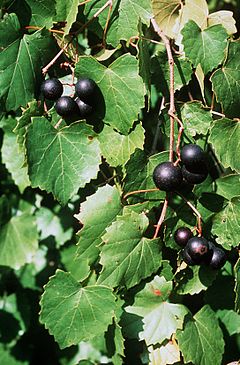 | |
| Scientific classification | |
| Kingdom: | Plantae |
| Division: | Magnoliophyta |
| Class: | Magnoliopsida |
| Order: | Vitales |
| Family: | Vitaceae |
| Genus: | Vitis |
| Subgenus: | Muscadinia |
| Species: | V. rotundifolia |
| Binomial name | |
| Vitis rotundifolia Michx. | |
Other products[edit|edit source]
Other traditional Southern U.S. muscadine-derived food products are readily available: jelly, preserves, syrup, and sauce. The fresh grape is available in season, September and October.[8] The juice is available, white and colored. Raisins are used to make the wine (scuppernong), but are not generally available. Mississippi State University produces and sells Muscadine Ripple ice cream at the MAFES Sales Store.
These are the big grape vines on a country road.(Bring your snake stick to whack the ground before you enter)
The big Garden Shop in Cypress had Portulaca and many other Hot Bloomers:
http://en.wikipedia.org/wiki/Portulaca
Portulaca
From Wikipedia, the free encyclopedia
Portulaca (/ˌpɔrtjuːˈleɪkə/,[2] purslane) is the type genus of the flowering plant family Portulacaceae, comprising about 40-100 species found in the tropics and warm temperate regions. They are also sometimes known as Rose Moss or more commonly Moss Roses.
Common Purslane (Portulaca oleracea) is widely considered an edible plant, and in some areas an invasive type of weed. Some Portulaca species are used as food plants by the larvae of some Lepidoptera species including the Nutmeg (Hadula trifolii).
Purslane can be eaten raw or cooked, and lends itself to stir fry dishes. Some say it has a slight lemon-like taste and mushroom-like texture. It is relatively easy to grow in more northern climates, including the New England area in the United States.
| Portulaca | |
|---|---|
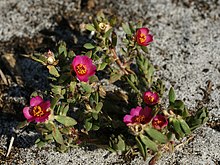 | |
| Portulaca amilis | |
| Scientific classification | |
| Kingdom: | Plantae |
| (unranked): | Angiosperms |
| (unranked): | Eudicots |
| (unranked): | Core eudicots |
| Order: | Caryophyllales |
| Family: | Portulacaceae |
| Genus: | Portulaca L.[1] |
| Species | |
about 40-100, see text
| |
Assorted Hot Bloomers that love the heat:
...this is brendasue signing off from Rainbow Creek. See You next time! Plant Flowers! Plant Trees! Keep them watered! You will receive rich rewards.
Inside Plants: Orchids
O+O

































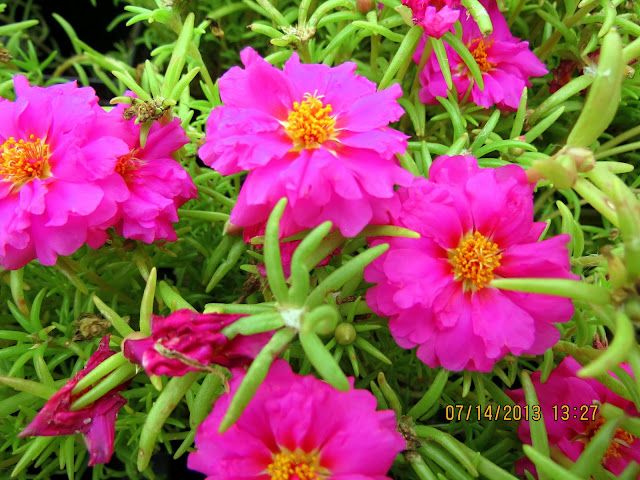




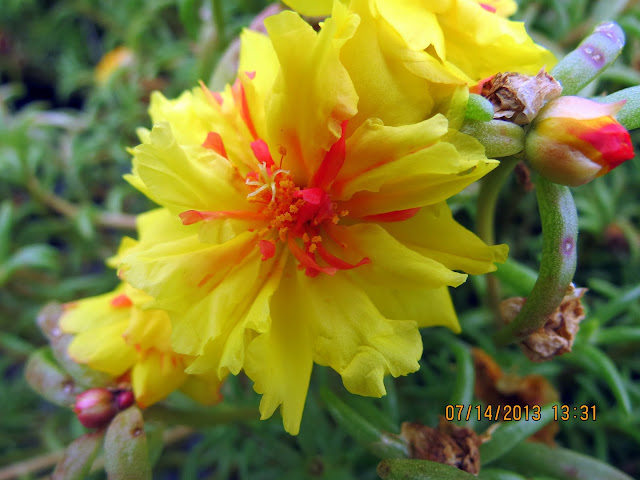































No comments:
Post a Comment
Hi Everybody! Please say hello and follow so I know you are here! Due to the inconsideration of people trying to put commercials on my blog comment area, I have restricted use of anonymous posts. Sorry that some hurt all.
My public email is katescabin@gmail.com No spammers or trolls